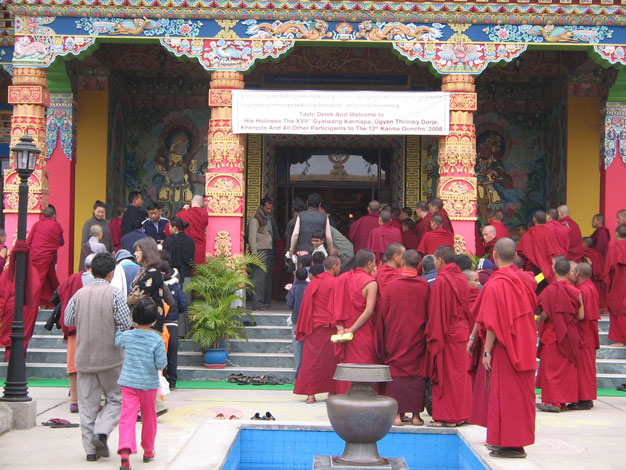法王新闻 | 2008年12月
為參加辯經法會僧眾開講中觀課程1
Gyalwang Karmapa begins teaching on Madhyamika
地點:印度 菩提加耶
時間:2008年12月15日 Monday 15th December, 2008
報導:Jo Gibson
攝影:Tashi Paljor

full moon day
每年於噶瑪辯經法會期間,法王噶瑪巴都會給予佛法課程的教授。今年法王噶瑪巴以第九世法王噶瑪巴旺秋多傑撰著的《 獅子吼:中觀概要》為教材,講說中觀課程。
Each year, during the Karma Gunchoe, the Gyalwang Karmapa gives a dharma teaching. Although strictly part of the Karma Gunchoe and not part of Kagyu Monlam, many of the Kagyu Monlam staff as well as
lay students of His Holiness and pilgrims attend these teachings. Consequently, for the first time, simultaneous translation into Chinese and English has been made available this year.
The teaching will be based primarily on The Lion’s Roar which Destroys Confusion, a text written by the 9th Karmapa Wangchuk Dorje
首先,法王噶瑪巴談到現今的交通比過去方便許多,也使朝聖之旅途能更加的便利,而不再需要發很大的決心與毅力,即可成辦。法王強調,即使如此,我們的動機與願心仍是最重要的。
In the first session, the Gyalwang Karmapa began by emphasizing the importance of motivation and intention these days, since modern methods of transport had made travel so much easier than in the past and great determination and
perseverance were no longer necessary.
來到菩提加耶朝聖或聽講佛法,若沒有正確的動機和願心,那就不會有真正的利益。此外,將焦點放在以感到殊勝和福氣的心能夠來到聖地朝聖,而不是只想著旅途可能遭遇到的困難,這是很重要的。期能運用來
到聖地的機會來體現佛法教證雙運的佛行事業。
Without correct motivation and intention, there would be no real benefit in travelling to Bodh Gaya on pilgrimage or to receive teachings. Further, it was important to
concentrate on the great fortune of being able to be here rather than on any difficulties we might have experienced or be experiencing, and use the opportunity fully to carry out the twin dharma activities of
study and practice.
法王詳述,在藏傳佛教中有著不同的傳承,但是學習不同宗派的論著及見解對學僧們而言,則是很重要的。
His Holiness then discussed how different traditions may have evolved within Tibetan Buddhism, and the importance of studying the texts and viewpoints of different schools.
最後,法王簡略概說中觀學說的發展演化,由清辯論師首先使用『中道』一詞在他的論著《般若燈論》中,來避免落入斷常二邊之論點。
Finally, he gave a brief overview of the development of Madhyamika philosophy, beginning with the great Bhavaviveka who first used the term the “middle way” which avoids the extremes of eternalism and nihilism, in his treatise Lamp of Wisdom.


